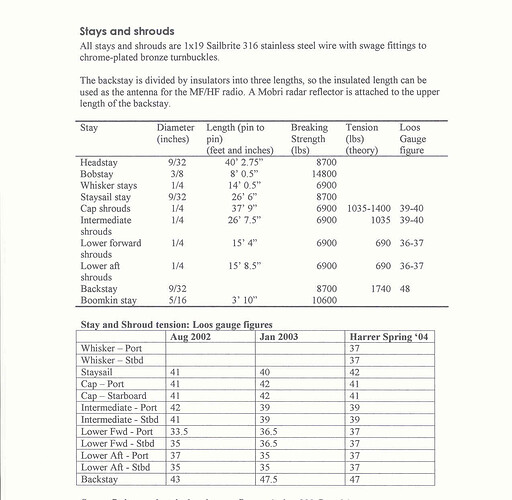wfraser Wrote:
I’m doing my first dockside rig tuning and after
studying Brion Toss’ video on the subject I’m left
scratching my head as to how to tune the bowsprit
and boomkin.
I’m hoping for some rules of thumb, something
general that will help me recognize if I’m getting
close.
Here are a few thoughts, based on years of racing dinghys with very bendy masts and adjustable rigs, and just a little experience setting up Itchen’s very unbendy Forespar mast. Surely there are many out there with a lot more experience with BCC rig tune?! First time i did it I checked Toss to see what he had to say and saw nothing to disagree with – a lot of books have been written on the subject and there’s much similarity of approach
Currently, the boomkin’s two short shrouds are
very tight, as in bar tight. This makes sense to
me given the short length of the wire and what I
imagine would be considerable load in a heavy
seaway.The bowsprit bobstay is similarly
tensioned. This too makes sense to me, but then
again, I’m not sure. The bowsprit shrouds are
tensioned to fairly firm, I would say similar to
my newly-tuned (Toss, again) mast lowers, but
given the loads and the occasional strolls I take
on the bowsprit shrouds, I’m wondering if they are
firm enough. All these shrouds and such have
turnbuckles.
When eyeballed, the bowsprit does not appear to
dip or climb and the same can be said for the
boomkin.
That’s what you want to see, no bend in the bowsprit, and the boomkin the same.
Next the mast in column with no bend and with whatever rake seems appropriate. Rake is already more or less fixed unless the step is movable. My feeling based on Itchen’s performance and comments of others is to aim for as little aft rake as one can manage to avoid any more weather helm than probably already exists.
Then I set up the lower and upper shrouds snugly but not too tight and use the main halliard to make sure that the masthead is centered athwartships. Just cleat it at an appropriate length and see if it touches the gunwale equally port & stbd. Then I set up headstay and backstay quite tight, and the staysail stay less so and eyeball the mast to see if it is still “in column” with no bend. Obviously, the lower shrouds versus the staysail stay will interact and have a lot to do with fore and aft bend and sidewise “S curves” which are definitely to be avoided! After all looks good I then crank up the tension on the backstay and headstay until it is “just right”. Impossible to quantify, but one wants to avoid headstay sag in a breeze as much as is reasonable so IMHO this is the critical adjustment and should be quite tight. The do whatever is needed to bring the staysail stay into synch with everything else. Then eyeball the mast column again and make sure no nasty curves have appeared.
Fianlly, go sailing in a 2-reef breeze and see how it looks when going to windward. Mast should still be straight with minimal leeward sag at the masthead and the leeward uppers & lowers should still be snug – not “bar tight” but certainly not flopping around. Then get another BCC to match race with you (Iduna are you there?) and make fussy little adjustments to get those last few seconds per mile improvement in rig tune. Just kidding, I think the BCC has a very unfussy rig and a basic setup works fine and can be left untouched once “in the ballpark”. A Loos tension gauge is nice for tuning racing dinghys but probably overkill for a BCC, but gadgets are fun, so why not, (especially if you can borrow one from a hot one design racer)!
I found the trickiest adjustment to be backstay and headstay versus bobstay so as to get adequate headstay tension without bowsprit bend. The bowsprit whisker stays (shrouds) need to be quite tight – I think it is hard to over do this, as there is a lot of sidewise pressure when hard on the wind, and I like not having them wobble back & forth when used as a foot rest.
I don’t have a Loos guage (yet) and am using Toss’
push/pull/listen approach. So far so good. The
wood mast is standing straight with a very slight
bend to stern at the top (This is okay for a
wooden mast, isn’t it?)
I’m the wrong peron to comment on this – it has been over forty years since I had anything to do with a wooden mast, all my practical experience is with aluminum masts. I’d be VERY careful about too much bend, or any “s-curve” at all. There are just opinions, I have no special expertise and would be interested in the experiences of other BCC owners. Anyone ever lose their rig in a blow?
Thanks heaps for any pointers or advice.
Warren Fraser
Warren Fraser
s/v Voyager of Yokohama
Edited 1 times. Last edit at 03/31/08 06:09AM by
wfraser.
